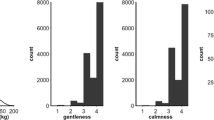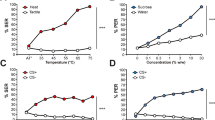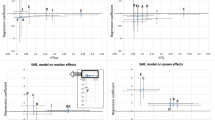Abstract
The learning behavior of Cape honeybees (Apis mellifera capensis) is examined using conditioning of the proboscis extension reflex. The bees are tested cumulatively with several learning tests. The genetic influence on differences in the learning scores is calculated by means of heritability (h 2) estimations obtained by different methods. Theh 2 values of the sum of the trials derived by each method range between 0.39 and 0.54. This shows that the proboscis extension reflex paradigm is suitable for the characterization and selection of genetic differences in learning behavior. Heritabilities in the narrow sense and in the broad sense are in the same range. The small differences obtained are discussed with respect to the type of selection existing in natural populations.
Similar content being viewed by others
References
Bitterman, M. E., Menzel, R., Fietz, A., and Schäfer, S. (1983). Classical conditioning of proboscis extension in honeybees (Apis mellifera).J. Comp. Psychol. 97(2):107–119.
Collins, A. M., Rinderer, T. E., Harbo, J. R., and Brown, M. A. (1984). Heritabilities and correlation for several characters in the honey bee.J. Hered. 75:135–140.
Falconer, D. S. (1981).Introduction to Quantitative Genetics, 2nd ed., Longmans, London.
Free, J. B. (1958). The ability of worker honeybees (Apis mellifera) to learn a change in the location of their hives.Anim. Behav. 6:219–223.
Frings, H. (1944). The loci of olfactory end-organs in the honey-bee Apis mellifera Linn.J. Exp. Zool. 97:123–134.
Fuller, J. L. (1983). Ethology and behavior genetics. In Fuller, J. L., and Simmel, E. C. (eds.),Behavior Genetics, Lawrence Erlbaum Associates, Hillsdale, N.J., pp. 337–362.
Hewitt, J. K., Fulker, D. W., and Hewitt, C. A. (1983). Genetic architecture of olfactory discriminative avoidance conditioning in Drosophila melanogaster.J. Comp. Psychol. 97(1):52–58.
Hillesheim, E. (1983). Vererbbarkeit von physiologischen und ethologischen Merkmalen beiApis mellifera capensis, Dipl. Arb. Fachb. Biol. Universität Frankfurt, Frankfurt.
Kauhausen, D. (1978). Genetische Analyse der thelytoken Parthenogenese bei der Kap-Honigbiene (Apis mellifera capensis). Dipl. Arb. Fachb. Biol. Universität Frankfurt, Frankfurt.
Kuwabara, M. (1957). Bildung des bedingten Reflexes von Pavlovs Typus bei der Honigbiene Apis mellifica.Hokkaido Univ. Zool. J. Fac. Sci. 13:458–464.
Lauer, J., and Lindauer, M. (1971). Genetisch fixierte Lerndispositionen bei der Honigbiene. InInformationsaufnahme und Informationsverarbeitung im lebenden Organismus, Abh. Akad. Wiss. Mainz, pp. 1–87.
McClearn, G. E. (1967). Genes generality and behavioural research. In Hirsch, J. (ed.),Behavior-Genetic Analysis, McGraw-Hill, New York, pp. 307–321.
McGuire, T. R., and Tully, T. (1987). Characterization of genes involved with classical conditioning that produce differences between bidirectionally selected strains of the blow flyPhormia regina.Behav. Genet. 17:97–107.
Menzel, R. (1969). Das Gedächtnis der Honigbiene für Spektralfarben. II. Umlernen und Mehrfachlernen.Z. Vergl. Physiol. 63:290–309.
Menzel, R., and Bitterman, M. E. (1983). Learning by honeybees in an unnatural situation. In Huber, F., and Markl, H. (eds.),Neuroethology and Behavioral Physiology, Springer-Verlag, Berlin, Heidelberg, pp. 206–215.
Menzel, R., Freudel, H., and Rühl, U. (1973). Rassenspezifische Unterschiede im Lernverhalten der Honigbiene (Apis mellifica L.).Apidologie 4(1):1–24.
Menzel, R., Erber, J., and Masuhr, Th. (1974). Learning and memory in the honeybee. In Barton-Browne, L. (ed.),Experimental Analysis of Insect Behaviour, Springer-Verlag, Berlin, Heidelberg, New York, pp. 195–217.
Moritz, R. F. A., and Brandes, Ch. (1987). Behavior genetics in honeybees. In Menzel, R., and Mercer, E. (eds.),Neurobiology and Behavior in Honeybees, Springer-Verlag, New York, pp. 21–35.
Mortiz, R. F. A., and Klepsch, A. (1985). Estimation heritabilities of worker characters: A new approach using laying workers of the cape honeybee (Apis mellifera capensis Esch.)Apidologie 16(1):47–56.
Oldroyd, B., and Moran, C. (1983). Heritability of worker characters in the honeybee (Apis mellifera).Aust. J. Biol. Sci. 362:323–332.
Onions, G. W. (1912). South African “fertile worker bees”.Agr. J. Union S. Afr. 3:720–728.
Onions, G. W. (1914). South African “fertile worker bees”.Agr. J. Union S. Afr. 7:44–46.
Opfinger, E. (1949). Zur Psychologie der Duftdressuren bei Bienen.Z. Vergl. Physiol. 31:441–453.
Pirchner, F. (1979).Populationsgenetik in der Tierzucht, 2nd ed., (Verlag Paul Parey, Hamburg, Berlin.
Pirchner, F., Ruttner, F., and Ruttner, H. (1962). Erbliche Unterschiede zwischen Ertragseigenschaften von Bienen.XI Int. Kongr. Entomol. Wien Bd. 2:510–516.
Ribbands, C. R., and Speirs, N. (1953). The adaptibility of the homecoming honeybee.Br. J. Anim. Behav. 1:59–66.
Rinderer, T. E. (1977). Measuring the heritability of characters of honeybees.J. Apic. Res. 16(1):95–98.
Ruttner, F. (1976). Die Bienenrassen Afrikas. Verh. XXV Bienenzüchterkongress, pp. 344–364.
Ruttner, F. (1977). The problem of the Cape bee (Apis mellifera capensis Escholtz): Parthenogenesis-size of population-evolution.Apidologie 8(3):281–294.
Ruttner, F., and Hesse, B. (1981). Rassenspezifische Unterschiede in der Ovarentwicklung un Eiablage von weisellosen Arbeiterinnen der Honigbiene Apis mellifera L.Apidologie 12(2):159–183.
Soller, M., and Bar-Cohen, R. (1967). Some observations on the heritability and genetic correlation between honey production and brood area in the honey bee.J. Apic. Res. 6(1):37–43.
Verma, S., and Ruttner, F. (1983). Cytological analysis of the thelytkokous parthenogenesis in the Cape honeybee (Apis mellifera capensis Escholtz).Apidologie 14(1):41–57.
Wahlsten, D. (1972). Genetic experiments with animal learning: A critical review.Behav. Biol. 7:143–182.
Wright, S. (1922). Coefficients of inbreeding and relationship.Am. Nat. 56:330–338.
Author information
Authors and Affiliations
Additional information
This study was supported by the Deutsche Forschungsgemeinschaft (Br 827/1-2).
Rights and permissions
About this article
Cite this article
Brandes, C. Estimation of heritability of learning behavior in honeybees (Apis mellifera capensis). Behav Genet 18, 119–132 (1988). https://doi.org/10.1007/BF01067081
Received:
Accepted:
Issue Date:
DOI: https://doi.org/10.1007/BF01067081




